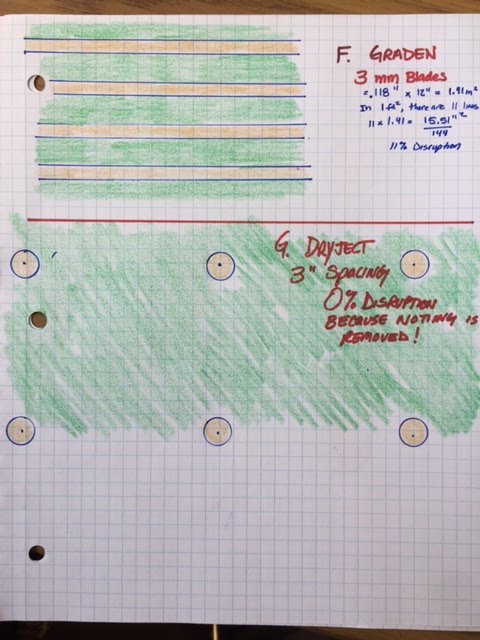Greens Aerification is the most dreaded process to any golfer! Superintendents everywhere, poke holes in the greens when they are near perfect, only to make the next 3 weeks miserable on everyone. Can't they do this when no one is here?? This is a seasonal Club, we shouldn't have to endure any of this nonsense. Every Superintendent has heard comments like this and I suspect, as long as the golf industry is alive and well, we will continue to hear such things.
For years, the USGA used to say that in order to keep USGA spec greens healthy and draining, Superintendents needed to disrupt 20% or more of the greens surface in a given year. Below, I used graph paper to show you the spacing of holes using different size tines. On example A, 3/4" tines on a 1.5" hole spacing will disrupt 19.5%. This is unrealistic because tines this large spaced this close would take a month or more to heal. As superintendents, we want to minimize the length of time that holes are exposed because these voids create the perfect spot for moss or Poa annua to invade. But, theoretically, one aerification at this size, would be enough to remove organic matter at a rate of what was being produced in a given year. Example B, is 3/4" tines on a 2"x2" spacing, resulting in 11% disruption. This means it would require 2 aerifications like this in a given year to keep up with thatch production.


If you used 1/4" tines on a 1.5" hole spacing, it would require 10 aerifications like this annually. Again, not very feasible.
Below, when we look at Drill and Fill, visually we are misled by thinking we are doing far more than we really are. The problem with Drill and Fill, is the hole spacing is so far apart at 5" centers. In short, this is about equal to the 1/4" tine mentioned above.
Finally, there is DryJect. This counts as 0% disruption because nothing is removed. DryJect is a tool, one used to incorporate sand, not as a means to reduce organic matter accumulation. Several years ago, the USGA changed their stance on this and rather than simply say 20% disruption, they now look at it in terms of sand incorporated in a given year. 3,000 to 4,000 pounds of sand per 1,000 square feet is the USGA recommendation. This sand can be incorporated through topdressing, filling aerification holes, DryJect or other methods we use. At HCC, we incorporate between 4,500-5,000lbs of sand per year and disrupt approximately 22% of the surface each year. As you can see, I still think it's important to abide by the disruption recommendation because from a drainage perspective, the small channels of sand within the greens are very beneficial.
We monitor the success of out program by visual inspections and scientific analysis of samples we send to ISTRC (International Sports Turf Research Center). They will break the sample down inch by inch and tell you the % of sand in each section. When the organic matter % reaches 3% in the top inch, buckle up because problems are about to start. At 4%, you are well on your way to failed greens. Once you reach that point, it's usually too late. If you think aerification is a bear at maintenance levels, you have experienced what it would be like to reverse course due to years of neglect or "holding off" on greens aeration because of various events.
Trust me when I say that superintendents hate greens aerification more than golfers but there isn't anything more important that we do to provide excellent conditions day in and day out. Please remember that this isn't some arbitrary decision made by the super. It is a carefully calculated program designed to meet the expectations of the membership. Members who want firm and fast greens, need to be more tolerant of aerification and sanding. After all, that's what produces those conditions.


